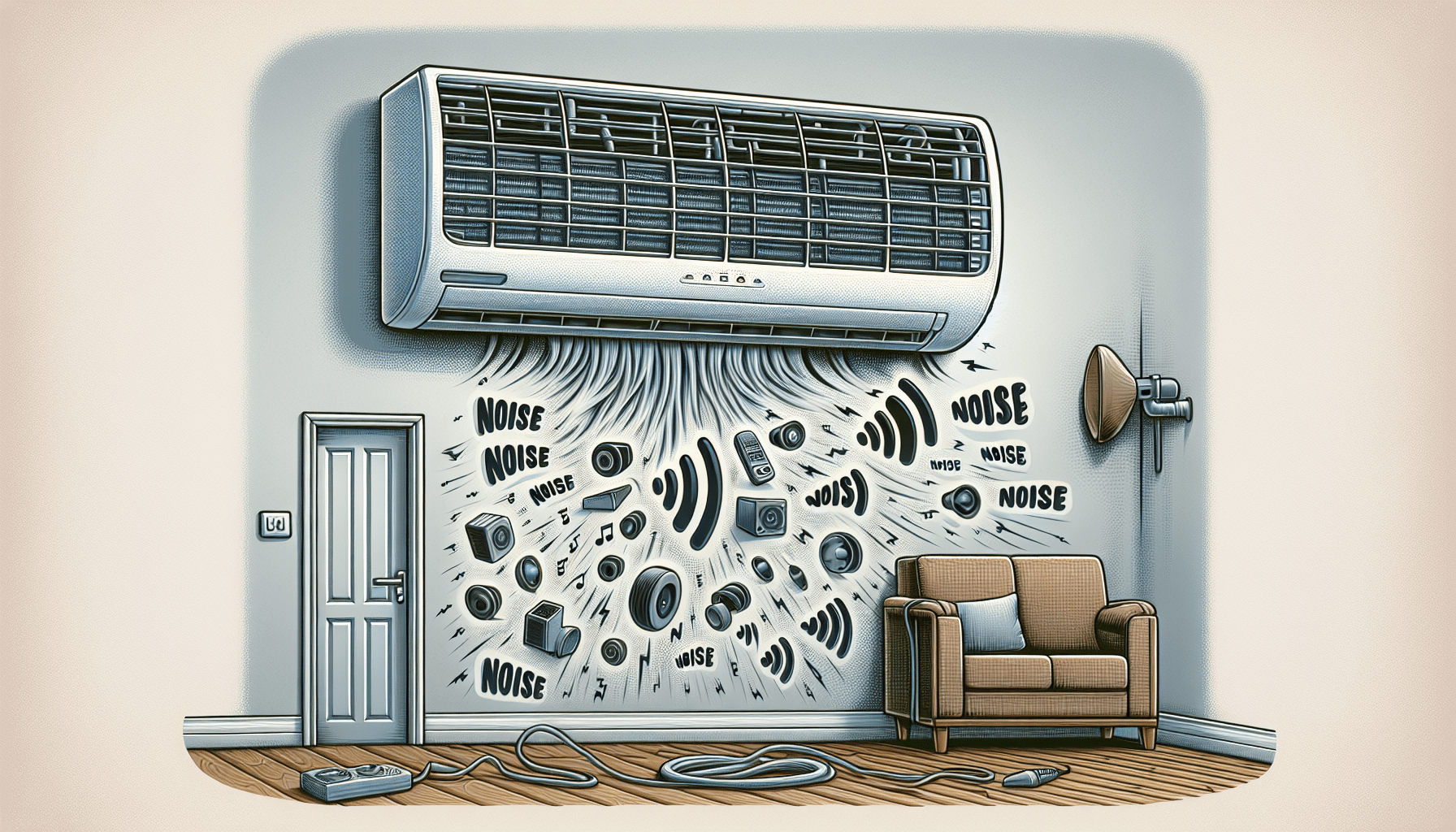Is the constant buzzing, rattling, or groaning of your air conditioning unit driving you insane? Don’t worry, we’ve got you covered. In this article, we will explore the best ways to troubleshoot a noisy air conditioning unit. Whether it’s a simple fix or a more complex issue, we’ll guide you through the steps to bring back the peace and tranquility in your home. So sit back, relax, and let’s get started on quieting down that noisy AC!
Understanding the Type of Noises
When dealing with a noisy air conditioning unit, the first step is to identify the type of noise you are hearing. Is it a rattling sound, a buzzing noise, or a grinding sensation? By determining the specific type of noise, you can narrow down the possible causes and find the appropriate solution.
To better understand the type of noise, compare it with standard AC sounds. Keep in mind that air conditioning units do produce some level of noise during operation, such as the sound of the compressor starting or the fan spinning. If the noise you are hearing is significantly different or louder than these normal sounds, it may indicate a problem.
Another key factor to consider is whether the noise is continuous or intermittent. A continuous noise could imply a more serious issue, whereas an intermittent noise may be easier to troubleshoot. Pay close attention to when and how often the noise occurs to gather more information that will assist in the troubleshooting process.
Check the Outdoor Condenser Unit
The outdoor condenser unit is an essential component of your air conditioning system, and it can be a common source of noise. Begin by examining the external fan and its blades. Look for any signs of damage or misalignment. If the fan blades are bent or obstructed, it can cause vibrations and create excessive noise. In such cases, gently straighten or clean the blades, ensuring they are properly aligned.
Next, check for any debris in the unit. Leaves, twigs, or other objects may have gotten into the condenser, causing an obstruction or interfering with the fan’s performance. Clear any visible debris to restore proper airflow and reduce unnecessary noise.
It’s also important to determine if the unit is vibrating against any surfaces. Inspect the base of the condenser unit and ensure that it is securely positioned. Vibrations caused by loose or uneven mounting can generate substantial noise. If necessary, adjust or tighten the mounting to minimize vibrations.

Examine the Indoor Unit
Moving indoors, inspecting the indoor unit is crucial for identifying the source of the noise. Start by checking for loose or broken components within the unit. Loose panels or brackets can create rattling or banging noises when the AC is operating. Tighten any loose screws or replace broken parts to eliminate the noise.
Next, take a look at the air filter. A clogged or dirty filter can restrict airflow, resulting in unusual sounds. Remove the filter and clean or replace it according to the manufacturer’s recommendations. A clean air filter not only reduces noise but also improves the efficiency of your air conditioning unit.
Additionally, assess the blower motor and its wheel. A worn-out or damaged motor or wheel can produce grinding or squealing noises. If you notice any signs of damage or excessive wear, it may be necessary to replace the motor or wheel to restore smooth and quiet operation.
Inspect the Ductwork
The ductwork plays a vital role in distributing cooled air throughout your home, and it can be a potential source of noise. Begin by inspecting the ducts for any holes or leaks. Small openings in the ductwork can create whistling or hissing sounds as air escapes. Seal any noticeable holes or leaks using appropriate duct tape or mastic to restore proper airflow and reduce noise.
Next, check for improper installation or damage in the ductwork. Ducts should be properly secured and insulated to prevent vibrations or rattling noises. Additionally, ensure that there are no obstructions or damage that may impede the airflow. Making any necessary adjustments or repairs to the ductwork can significantly reduce noise levels.
Lastly, evaluate the noise resulting from air escaping the ducts. Listen for any unexpected sounds, such as excessive airflow or a whistling noise. These noises may indicate issues with the ductwork design or installation, and it’s advisable to consult a professional for further assessment and resolution.

Evaluate the Refrigerant Levels
Inadequate refrigerant levels can lead to various problems, including noisy operation. To evaluate the refrigerant levels, monitor the AC’s cooling capability. If you notice that your air conditioning system is no longer effectively cooling your space, it could indicate a refrigerant issue.
Observe the refrigerant lines for any signs of frost. Frost on the lines may suggest a refrigerant leak. A refrigerant leak not only disrupts the cooling capacity but also generates a hissing sound as the high-pressure refrigerant escapes. If you suspect a refrigerant leak, it’s essential to seek professional assistance as handling refrigerants requires specialized knowledge and equipment.
Assess the Fan
The fan is an integral part of your air conditioning unit and is responsible for circulating the cooled air. A malfunctioning fan can be a significant source of noise. Begin by checking the fan motor. Listen for any unusual sounds, such as grinding or squealing noises, which may indicate motor issues. A professional may need to inspect and repair the motor if necessary.
Inspect the fan belt as well. A loose or worn-out fan belt can produce a high-pitched squeaking noise. If the belt appears loose or shows signs of wear, tightening or replacing it can resolve the noise problem.
Additionally, look for any damage or imbalance in the fan blades. Bent or damaged blades can cause vibrations and result in excessive noise. If you notice any issues, consider replacing the damaged blades or the entire fan assembly for smoother and quieter operation.
Thermostat and Control Panel Check
The thermostat and control panel are the command center of your air conditioning unit. Malfunctions or issues with these components can contribute to noisy operation. Start by inspecting the control panel for any visible malfunctions or loose connections. Loose wires or damaged components may result in erratic behavior and noise. If you notice any issues, it’s advisable to consult a professional for further assessment and repair.
Next, look for issues in the wiring. Frayed or damaged wires can cause electrical disruptions and generate buzzing or crackling noises. If you notice any exposed or damaged wiring, it’s crucial to address it promptly to ensure safe and quiet operation of your air conditioning system.
Finally, ensure the thermostat is functioning correctly. Incorrect temperature readings or irregular cooling cycles can lead to excessive noise. Verify that the thermostat is calibrated properly and that it accurately reflects the desired temperature. If you encounter any issues, consult a professional to repair or replace the thermostat as needed.
Professional Inspection
While DIY troubleshooting is helpful, it’s essential to get your air conditioning unit inspected by a professional technician. A professional inspection provides a comprehensive assessment of your entire system and can pinpoint any underlying issues contributing to the noise. During the inspection, the technician will perform a complete system diagnosis, checking all components and identifying potential sources of noise.
Based on the findings, the technician can discuss possible repairs or replacements. They will recommend the most appropriate course of action to resolve the noise issue and ensure the efficient and quiet operation of your air conditioning unit. Following their recommendations and undertaking the necessary repairs or replacements will help restore the comfort of your home.
Regular Maintenance
Regular maintenance is key to keeping your air conditioning unit in excellent condition and preventing noise-related problems. Formulate a regular maintenance schedule, including routine inspections and necessary tasks.
Performing regular filter changes is critical for maintaining optimal airflow and noise reduction. Clogged or dirty filters can strain the system, leading to increased noise levels. Follow the manufacturer’s guidelines and replace the filters as recommended.
Furthermore, ensuring the unit is clean and free from debris is important. Regularly inspect and clean both the indoor and outdoor components. Remove any dirt, dust, or debris that may accumulate and affect the system’s performance or generate noise. A clean unit operates more efficiently and quietly.
Upgrade or Replacement
If you have an older air conditioning unit that frequently makes noises, it may be time to consider an upgrade. Older units are more prone to wear and tear, and their components may no longer function optimally. By upgrading to a newer model, you can benefit from improved technology and quieter operation, enhancing your overall comfort.
When evaluating whether to repair or replace your AC unit, consider the cost-effectiveness of each option. If the repairs required are extensive and costly, it may be more advantageous in the long run to invest in a new unit. Additionally, factor in the potential energy savings and improved efficiency that come with modern AC units.
To make an informed decision, research modern and quieter AC units available on the market. Look for models with high ratings for noise reduction and energy efficiency. Consulting with a professional can also provide valuable insights and guidance in selecting the best unit for your specific needs.
In conclusion, troubleshooting a noisy air conditioning unit involves understanding the type of noises, checking the outdoor condenser unit, examining the indoor unit, inspecting the ductwork, evaluating the refrigerant levels, assessing the fan, checking the thermostat and control panel, conducting regular maintenance, considering professional inspection, and exploring upgrade or replacement options. By following these steps and taking appropriate action, you can restore peace and quiet to your home while enjoying the benefits of a properly functioning air conditioning system.





